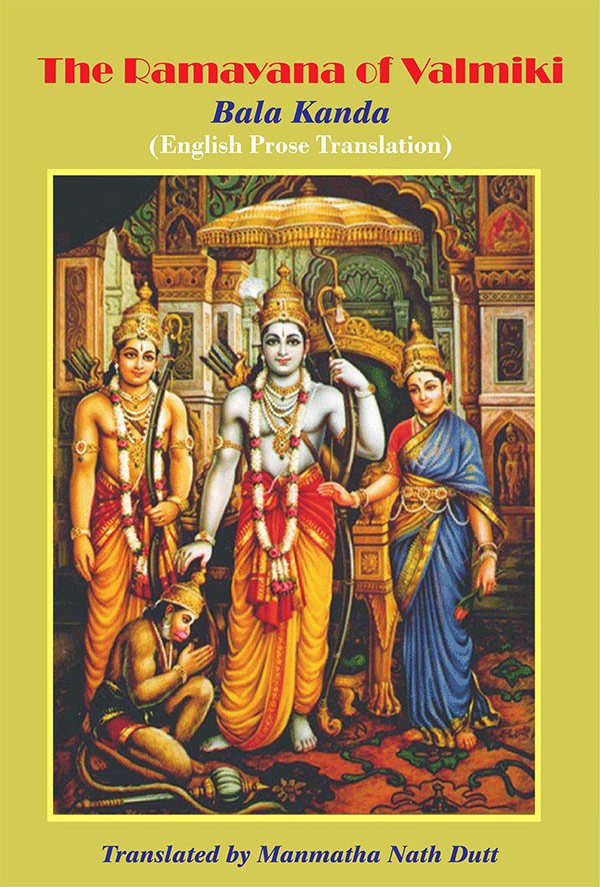Ramayana
by Manmatha Nath Dutt | 1891 | ISBN-13: 9788171101566
This page describes Chapter III of the English translation of the Ramayana, one of the largest Sanskrit epics of ancient India revolving around the characters Rama, Sita and Ravana. It was orignally authored by Valmiki at least over 2500 years ago. This is the first book of the Bāla-kāṇḍa (Bala-kanda) of the Ramayana, which consists of 24,000 Sanskrit metrical verses divided oer seven books.
Chapter III
Having heard the entire prevalent history of the intelligent Rāma, capable of conferring religious merit and the two other cognate objects, as well as emancipation, Vālmīki again sought to get insight into it
And, sitting himself facing the east on a cushion of kuśa grass, and sipping water according to the ordinance, he addressed himself to the contemplation of the subject through Yoga.
And by virtue of his Yoga powers, he clearly observed before him Rāma, and Lakṣmaṇa, and Sītā, and Daśaratha together with his wives in his kingdom, laughing, and talking, and acting, and bearing themselves as in real life.
He also saw all that was endured by Rāma firm in promise, with his wife as the third accompanist roaming in the forest
And like an embolic myrobalan on his palm, that righteous-souled sage by virtue of his yoga, perceived all that had happened as well as all that would happen in the past.
Having truly seen everything by virtue of his contemplation, that magnanimous one set about recording the charming Rāma’s history.
And agreeably to what had been related by the mighty-souled Nāraḍa, that worshipful saint composed the history of Raghu’s line, conferring profit and pleasure, and impregnated with qualities fraught with them, and like to the ocean, abounding in riches, and captivating ear and mind.
Rāma’s birth, his mighty prowess, and kindness to all, and popularity, and forbearance, and goodness, and truthfulness.
And the wonderful converse he had with Visvāmitra; wedding of Janaka’s daughter; and breaking the bow; the hostilities of Rāma with Rāma (Paraśurāma); and the noble qualities of Daśaratha’s son: and Rāma’s installation; and the enmity of Kaikeyī; and the obstacle in the way of the installation; and the exile of Rāma; and the kings grief, lamentations, and departure for the other regions; and the grief of the subjects, and their dismissal (by Rāma to Ayodhyā); and the tidings of the lord of Niṣādas; and the charioteer’s return.
And the swimming of the Gaṅgā and Rāma sinter view with Bharadvāja; and his arrival at Citrakūṭa in consonance with Bharadvāja’s injunction.
And Rāma’s building a mansion there and sojourn; and Bharata’s arrival, and his propitiation of Rāma; and Rāma’s offering oblations to the manes of his father.
And the installation of the sandals; and Bharata’s dwelling at Nandigrāma: and Rāma’s removal to Daṇḍaka and killing of Virādha.
And Rāma’s interview with Śarabhaṅga and meeting with Sutīkṣna; and Sītā’s companionship with Anasūyā, and the latter’s painting the former.
And Rāma’s interview with Agastya, and his obtaining the bow from him; and the dialogue of Śūrpaṇakhā and her disfigurement.
And the slaughter of Khara and Triśiras; and the exertions of Rāvaṇa; the killing of Mārīca, and the carrying away of Vaidehī.
Rāghava’s lamentations, and the death of the king of vultures; Rāma’s encounter with Kabandha, and his view of Pampā.
Rāma’s interview with Śabarī, and his subsistence there on fruits and roots; Rāma’s lamentations at Pampā, and meeting with Hanumān.
The former’s sojourn to the Rṣyamūka, and meeting with Sugrīva; Rāma’s raising the confidence of Sugrīva and his friendship with the latter; and the encounter between Vālī and Sugrīva.
The destruction of Vālī, and the installation of Sugrīva and Tārā’s lamentations; the understanding between Rāma and Sugrīva as to the time for commencing the march. Rāma’s stay at the wet night; and the ire of Rāma the lion of Raghu’s race; the levying of forces; and the despatch of envoys in deferent directions; and the assignment by Sugrīva of different quarters to the monkeys.
The making over of his ring by Rāma to Hanumān; Ṛkṣa’s discovery of the cave. The abstemious abode of the monkeys on the shore of the ocean; Hanumān’s interview with Sampāti.
Hanumān’s ascension of the mountain, and his bounding over the main; and his sight of the Maināka at the injunction of Ocean; the roaring of Rākṣasis; Hanumān’s meeting with the Rākṣasa Chāyāgrāha. Hanumān’s destruction of Siṃhikāyā; and Hanumān's sight of Laṅkā.
His entrance by night into Laṅkā; his ascertaining of conduct in times of helplessness; his journey to the Āpāna ground; and his sight of his car Puṣpaka; his walk to the Aśoka forest, and sight there of Sītā.
His presentation of the ring to Sītā and converse with her; and the roaring of the Rākṣasis; and the dreaming of the dream by Trijaṭā.
Sītā’s handing a gem to Hanumān; and the breaking down of trees; and the fight of the Rākaṣasis, and the slaughter of the salves.
The wind-god’s son being taken captive; and his terrible roars while burning down Laṅkā; and his bounding back over the ocean; and the forcible possession of honey.
Hanumān's consoling Rāghava, and handing him the gem; Rāma’s interview with ocean; and Nala’s constructing the bridge.
The army’s crossing of the ocean; and the nightly siege of Laṅkā; and Rāma, interview with Bibhishana; the communication as to the means of destruction.
And the killing of Kumbhakarṇa and Meghanāda; and the destruction of Rāvaṇa, and the recovery of Sītā in the enemy’s city.
And the coronation of Vibhīṣaṇa, and the sight of Puṣpaka; Rāma’s return towards Ayodhyā, and meeting with Bharadvāja.
Despatch of Hanumān; and Rāma’s meeting with Bharata; and the installation of Rāma; and the dismissal of all the forces.
Rāma’s pleasing his subjects and renunciation of Sītā,—alleles besides concerning Rāma on earth, that has not yet taken place,—have been dealt with by the worshipful sage in the following poem.
